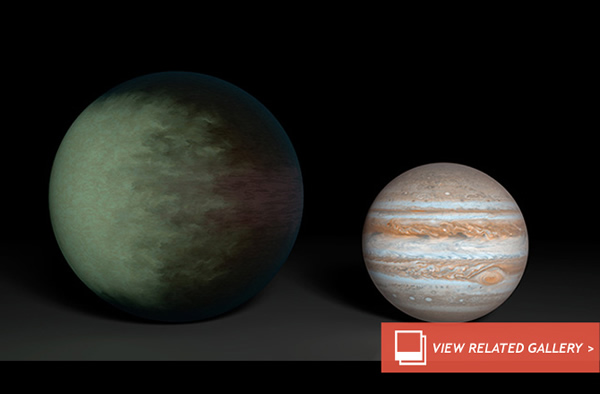Exoplanet Forecast: Cloudy, With Chance of Maelstrom
Exoplanet Forecast: Cloudy, With Chance of Maelstrom
Through the combined power of two NASA space telescopes, the clouds hanging high in an alien atmosphere have been mapped for the first time. But don’t go having romantic dreams of white puffy cumuli drifting over the landscape, these clouds are likely way beyond anything we could possibly imagine in our temperate biosphere.
Until recently, extrasolar planets — or exoplanets — could only be detected indirectly. But with the help of increasingly sophisticated optics, direct observations of these alien worlds have been possible. However, the “Holy Grail” of exoplanet studies will only be attained when we can directly probe the characteristics of the atmospheres of the smaller planetary bodies. Driving this exoplanetary fascination is the hunt for alien life and habitable worlds, but in the case of Kepler-7b — which has been studied by NASA’s Kepler and Spitzer space telescopes — it’s just the fact that we can see cloud structure in its atmosphere that has left astronomers buzzing.
“By observing this planet with Spitzer and Kepler for more than three years, we were able to produce a very low-resolution ‘map’ of this giant, gaseous planet,” said Brice-Olivier Demory, of Massachusetts Institute of Technology in Cambridge. “We wouldn’t expect to see oceans or continents on this type of world, but we detected a clear, reflective signature that we interpreted as clouds.”
Data from NASA’s Kepler space telescope has confirmed the discoveries of over 150 exoplanets (with hundreds more candidate exoplanets) of which Kepler-7b was one of the first of the mission’s confirmed worlds. The exoplanet orbits very close to its host star and is a puffed-up “hot-Jupiter” — it is about half the mass of Jupiter and yet 1.5 times the gas giant’s physical size.
Kepler has recently ceased its exoplanet-hunting operations due to a failed reaction wheel, but during its four years of science operations, the orbiting telescope watched planets pass in front of their host stars, creating small dips in starlight brightness as they did so. While watching for these “transits,” more information could be gleaned from the reflected starlight off Kepler-7b’s atmosphere. The moon-like phases observed during the world’s orbit around its star revealed bright structure in the exoplanet’s western atmosphere.
During follow-up infrared studies by Spitzer, the temperature of the structure could be gauged. Spitzer deduced that Kepler-7b’s atmosphere is between 1,100 and 1,300 Kelvin (1,500 and 1,800 degrees Fahrenheit), much cooler than would be expected for an atmosphere of a planet that orbits so close to its star.
“Kepler-7b reflects much more light than most giant planets we’ve found, which we attribute to clouds in the upper atmosphere,” said Thomas Barclay, Kepler scientist at NASA’s Ames Research Center in Moffett Field, Calif. “Unlike those on Earth, the cloud patterns on this planet do not seem to change much over time — it has a remarkably stable climate.”
Stable it may be, but the atmospheric conditions on Kepler-7b are hellish — hot with (likely) powerful global winds driven by a star only 0.06 AU (6 percent of the Earth-sun distance) away.
This study is an exciting glimpse into the possible future of observing and characterizing exoplanets; particularly smaller, Earth-sized worlds that possess temperate environments possibly habitable to life as we know it. Detecting cloud and other atmospheric features of small alien worlds will help us understand the frequency of true “Eath-like” planets.
“With Spitzer and Kepler together, we have a multi-wavelength tool for getting a good look at planets that are trillions of miles away,” said Paul Hertz, director of NASA’s Astrophysics Division in Washington. “We’re at a point now in exoplanet science where we are moving beyond just detecting exoplanets, and into the exciting science of understanding them.”
The Kepler-7b study has been accepted for publication in the Astrophysical Journal Letters.
Image: Kepler-7b, which is 1.5 times the radius of Jupiter, is the first exoplanet to have its clouds mapped. The cloud map was produced using data from NASA’s Kepler and Spitzer space telescopes. Image credit: NASA/JPL-Caltech/MIT(Oct 1, 2013 04:18 PM ET // by Ian O'Neill)












